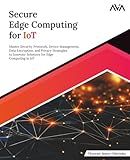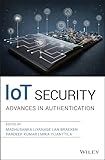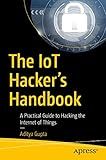Best IoT Security Solutions to Buy in December 2025

Practical IoT Hacking: The Definitive Guide to Attacking the Internet of Things



The Hardware Hacking Handbook: Breaking Embedded Security with Hardware Attacks



IoT and Edge Computing for Architects: Implementing edge and IoT systems from sensors to clouds with communication systems, analytics, and security



Secure Edge Computing for IoT: Master Security Protocols, Device Management, Data Encryption, and Privacy Strategies to Innovate Solutions for Edge ... (Blockchain Security — Enterprise Path)



IoT Security: Advances in Authentication



The IoT Hacker's Handbook: A Practical Guide to Hacking the Internet of Things


Securing IoT (Internet of Things) devices is crucial to protect them from cyberattacks and ensure the privacy and safety of users. Here are some key considerations for securing IoT devices:
- Authentication and Access Control: Implement strong authentication mechanisms like passwords, biometrics, or two-factor authentication to ensure only authorized individuals can access the device's interface and data.
- Firmware Updates and Patch Management: Regularly update the device's firmware to fix vulnerabilities. Manufacturers should provide prompt security patches, and users must apply these updates as soon as they become available.
- Encryption: Use encryption techniques, such as Transport Layer Security (TLS), to secure data transmission between IoT devices and the network they are connected to. Encrypting sensitive information prevents unauthorized interception and manipulation.
- Secure Communication Protocols: Choose secure communication protocols like HTTPS, MQTT with TLS, or CoAP with DTLS for communicating with IoT devices. These protocols add an extra layer of security to prevent eavesdropping and data tampering.
- Network Segmentation: Segregate IoT devices from the main network to minimize potential attack vectors. Use firewalls and VLANs (Virtual Local Area Networks) to create isolated, secure network segments for IoT devices.
- Secure Web Interfaces and APIs: Ensure that web interfaces and APIs used to access and manage IoT devices are secure. Implement proper authentication, encryption, and access controls to prevent unauthorized access or exploitation.
- Physical Security: Protect IoT devices physically by placing them in secure areas, restricting physical access, and tamper-proofing the hardware. Physical security measures can prevent unauthorized individuals from tampering with the devices.
- Implementing Defense-in-Depth: Apply a layered security approach by combining multiple security measures. This includes implementing firewalls, intrusion detection systems, and antivirus software to safeguard IoT devices from various types of attacks.
- Vendor Selection and Due Diligence: Choose trustworthy vendors who prioritize security in their IoT devices. Research their security track record, commitment to updates, and willingness to address vulnerabilities promptly.
- Continuous Monitoring and Response: Implement real-time monitoring and anomaly detection mechanisms to identify potential security breaches or unusual behavior. This facilitates quick responses to incidents, minimizing damage and potential risks.
Overall, securing IoT devices requires a holistic approach that combines technical measures, regular updates, and user awareness to protect against evolving cybersecurity threats.
How to conduct a vulnerability assessment for IoT devices?
Conducting a vulnerability assessment for IoT devices involves several steps to identify potential security weaknesses and address them proactively. Here is a step-by-step guide on how to conduct a vulnerability assessment for IoT devices:
- Identify and inventory IoT devices: Begin by identifying all the IoT devices present in your environment. Conduct a thorough inventory to ensure you have a comprehensive list.
- Research device vulnerabilities: Stay updated with the latest security vulnerabilities and threats related to IoT devices. Refer to vulnerability databases, security advisories, and vendor resources to gather information on known vulnerabilities for your specific devices.
- Understand the IoT device architecture: Gain a deep understanding of the architecture and components of each IoT device. Identify device interfaces, network protocols, communication channels, and any interconnections with other devices or systems.
- Perform network mapping: Map the network connections of your IoT devices to understand their reachability and the potential attack surface. This includes identifying all connected devices, routers, gateways, and communication protocols used.
- Conduct vulnerability scanning: Use vulnerability scanning tools to automatically identify weaknesses, vulnerabilities, and misconfigurations in your IoT devices. These tools can identify known vulnerabilities based on their signatures and test for common security issues.
- Penetration testing: Consider conducting penetration testing to assess the security posture of your IoT devices. Penetration testers simulate real-world attacks to identify vulnerabilities that may not be detected by automated scanning tools.
- Analyze results: Once the vulnerability scanning and penetration testing are completed, analyze the findings and prioritize the vulnerabilities based on their severity, potential impact, and ease of exploit.
- Address vulnerabilities: Develop a remediation plan to address identified vulnerabilities. This may involve applying security patches, firmware updates, or making specific configuration changes.
- Implement security controls: Enhance the security of your IoT devices by implementing security controls, such as network segmentation, robust authentication mechanisms, encryption, intrusion detection systems, and regular monitoring.
- Regularly reassess vulnerabilities: Vulnerabilities in IoT devices can emerge over time due to evolving threats and changes in the device landscape. Conduct regular vulnerability assessments to ensure ongoing security.
Remember to comply with ethical guidelines during vulnerability assessments and penetration testing, ensuring you have proper authorization and consent to test the devices.
How to audit third-party IoT device vendors for security practices?
Auditing third-party IoT device vendors for security practices requires a comprehensive approach to assess their level of security. Here are the steps to conduct such an audit:
- Define your requirements: Before auditing vendors, clearly identify your security requirements, including the type and level of security practices you expect from them. This will serve as the basis for evaluating their practices.
- Research and shortlist vendors: Conduct thorough research to identify potential vendors who provide the IoT devices you need. Consider their reputation, customer reviews, security track record, and previous security incidents, if any.
- Evaluate vendor security documentation: Request and review the vendor's security documentation, such as security policies, procedures, and standards. Look for evidence of strong encryption, secure coding practices, vulnerability management, and secure development life cycles.
- Assess physical security: Verify that the vendor has appropriate physical security measures in place, such as access controls, surveillance systems, and secure facilities, to safeguard their devices during manufacturing, storage, and transportation.
- Evaluate software security: Assess the vendor's software security practices. Review their software development processes, secure coding standards, vulnerability testing, and patch management processes. Check if they follow industry best practices and standards like the OWASP IoT Top 10.
- Review firmware and device updates: Determine if the vendor regularly updates their device firmware to address security vulnerabilities. Understand their processes for notifying customers of security updates, supporting over-the-air updates, and ensuring secure and timely patch deployment.
- Check third-party component usage: Investigate if the vendor uses any third-party components or software libraries in their devices. Verify that they have a robust system for monitoring and mitigating security vulnerabilities in these components.
- Assess data security and privacy: Examine how the vendor handles sensitive data collected by their devices. Evaluate their data encryption, data retention policies, user privacy controls, and consent mechanisms. Ensure compliance with relevant data protection regulations.
- Conduct vulnerability testing: Consider engaging a third-party security firm to perform penetration testing on the vendor's devices. This will help identify potential vulnerabilities and validate the effectiveness of their security practices.
- Audit supply chain security: Assess the vendor's supply chain security practices to ensure the integrity of their devices. Evaluate their vendor vetting processes, validation of firmware authenticity, and safeguards against tampering or counterfeiting during manufacturing and shipping.
- Evaluate incident response capabilities: Understand the vendor's incident response procedures, including their ability to detect, respond to, and communicate about security incidents. Ensure they have a well-documented and tested incident response plan.
- Request documentation and certifications: Request relevant security certifications, such as ISO 27001 or Common Criteria. While certifications do not guarantee security, they can provide some assurance regarding the vendor's commitment to best practices.
- Continuous monitoring: After selecting a vendor, establish a process for ongoing monitoring, periodic audits, and vendor reviews to ensure they maintain their security practices over time.
Remember that auditing vendors for security practices is an ongoing effort. Regular evaluations, vulnerability assessments, and continuous monitoring will help ensure the security of your IoT ecosystem.
What is the role of cryptography in securing IoT devices?
The role of cryptography in securing IoT (Internet of Things) devices is essential as it provides a framework for ensuring the confidentiality, integrity, and authenticity of data transmitted and stored by these devices. Here are some specific roles:
- Confidentiality: Cryptography helps in keeping the communication between IoT devices secure by encryption. It ensures that only the intended recipient can understand the data. Encryption algorithms like AES (Advanced Encryption Standard) are commonly used to protect sensitive information from unauthorized access.
- Integrity: Cryptographic techniques like digital signatures and message authentication codes (MACs) ensure the integrity of data transmitted by IoT devices. Digital signatures verify the authenticity and integrity of the data, ensuring that it has not been tampered with during transmission.
- Authentication: Cryptography facilitates the authentication of IoT devices and their communication partners. It helps in establishing trust among devices by verifying their identities and ensuring that they are communicating with legitimate and authorized entities. Public-key infrastructure (PKI) is commonly used for device authentication.
- Non-repudiation: Cryptography allows for non-repudiation, meaning that an entity cannot deny being involved in a particular communication or transaction. It prevents IoT devices from denying their actions or transactions, making them accountable for their actions.
- Key management: Cryptography helps in managing and securely distributing cryptographic keys to IoT devices. Proper key management ensures that encryption keys are protected, rotated, and updated regularly, minimizing the risk of unauthorized access.
In summary, cryptography plays a crucial role in securing IoT devices by providing mechanisms for confidentiality, integrity, authentication, non-repudiation, and key management. It ensures that data exchanged between IoT devices remains secure and trustworthy.
What is the impact of insecure IoT devices on the overall network security?
The impact of insecure IoT devices on overall network security can be significant. Here are some key points:
- Entry point for attacks: Insecure IoT devices can serve as entry points for hackers to gain unauthorized access to the network. Weak passwords, lack of encryption, and unpatched vulnerabilities in these devices make them prime targets for exploitation. Once compromised, hackers can gain control over the device and use it as a launching pad for further attacks on other devices and network resources.
- Botnets and DDoS attacks: Insecure IoT devices are often recruited into botnets, which are networks of compromised devices controlled by a central attacker. These botnets can be used for large-scale Distributed Denial of Service (DDoS) attacks, flooding the network or specific targets with overwhelming traffic. The sheer number of connected IoT devices can amplify the effect of these attacks, causing widespread disruption.
- Data breaches and privacy concerns: IoT devices often collect and transmit sensitive data, including personal information and sometimes even video and audio feeds. Insecure devices can be easily exploited to compromise this data, leading to potential data breaches. These breaches not only violate user privacy but can also result in financial loss or reputational damage for individuals and organizations.
- Network isolation and segmentation challenges: Insecure IoT devices can create challenges for network isolation and segmentation. Since some IoT devices may lack proper security controls, they can potentially breach and bypass network segmentation, gaining access to other network segments that are supposed to be separated. This poses a risk of lateral movement for attackers, enabling them to move from one segment to another, compromising the security of the entire network.
- Lack of centralized management and patching: IoT devices often have diverse manufacturers and do not follow standardized security practices. This can make it difficult to centrally manage and update them for security. As a result, devices may not receive security patches or firmware updates in a timely manner, leaving them vulnerable to known exploits. This lack of centralized management further increases the risk of compromised devices affecting overall network security.
To mitigate these risks, it is crucial to prioritize security in IoT device design, deployment, and ongoing management. Manufacturers should implement robust security controls, encryption, strong authentication mechanisms, regular firmware updates, and make security a core consideration throughout the device lifecycle. Additionally, users should follow best practices such as changing default passwords, isolating IoT devices on separate networks, and keeping them up to date with security patches.
How to protect IoT devices from dictionary and brute-force attacks?
To protect IoT devices from dictionary and brute-force attacks, you can follow these best practices:
- Strong Authentication: Ensure that your IoT devices use secure passwords or access keys. Avoid using default passwords and always change them to unique, strong, and complex passwords that include a mix of uppercase and lowercase letters, numbers, and special characters.
- Two-Factor Authentication (2FA): Implement two-factor authentication wherever possible to add an extra layer of security. This could involve a secondary verification method such as a unique code sent to a user's email or mobile device.
- Account Lockouts: Implement a mechanism that locks out an account temporarily after multiple incorrect login attempts. This helps prevent brute-force attacks by slowing down the attacker and making it difficult for them to guess the password.
- Rate Limiting: Set limits on the number of login attempts allowed within a specific time frame. By applying rate limiting, you can restrict the rate at which login attempts can be made, making it harder for attackers to perform brute-force attacks.
- Captcha and ReCAPTCHA: Implement captcha or reCAPTCHA challenges on login pages to ensure the user is a human and not an automated script or bot attempting to brute-force access.
- Firmware and Software Updates: Regularly update the firmware and software of your IoT devices. These updates often include security patches and bug fixes that address known vulnerabilities, reducing the risk of successful attacks.
- Network Segmentation: Separate your IoT devices from critical components of your network, such as servers and databases. This way, even if one device is compromised, the impact can be minimized.
- Intrusion Detection and Prevention Systems (IDPS): Deploy IDPS solutions to monitor network traffic and detect any suspicious activity or brute-force attempts in real-time. These systems can help prevent or mitigate attacks before they cause significant harm.
- Encryption: Encrypt communication between IoT devices and the associated applications or systems they interact with. This ensures that even if attackers intercept the communication, they cannot easily decipher the data.
- Device Monitoring: Regularly monitor your IoT devices for any abnormal behavior, unusual network traffic patterns, or unauthorized access attempts. By proactively detecting and mitigating threats, you can enhance overall device security.
Remember, implementing a combination of these measures provides a stronger defense against dictionary and brute-force attacks, significantly reducing the risk to your IoT devices.
